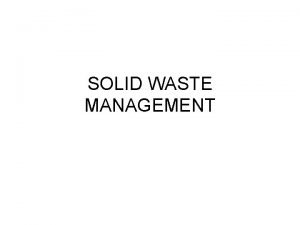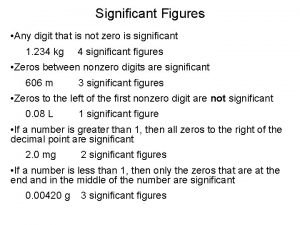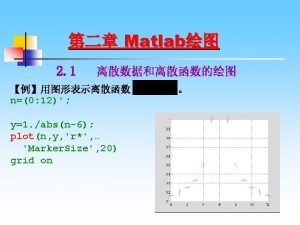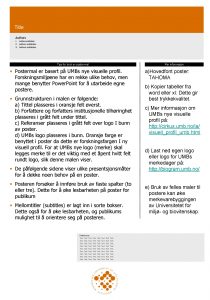The authors do not hold any financial interest












- Slides: 12

The authors do not hold any financial interest Residual Conjunctival Flora After 2 Regimes of Topical Vigamox: Prospective Randomized Triple-Masked Trial Dr. Shetal M. Raj, DO, MS Dr. D. U. Gajjar, Ph. D Dr. Abhay R. Vasavada, MS, FRCS Iladevi Cataract and IOL Research Centre, Ahmedabad, India

AIM To compare two dosing regimes of topically administered Vigamox (Moxifloxacin 0. 5%, Alcon Lab. , USA) with respect to: 1. Reduction in number of conjunctival bacterial flora 2. Bacterial species of conjunctival bacterial flora Study design Prospective Randomized Masked trial 80 patients undergoing phacoemulsification from December 2006 to December 2007.

Material and Method Sample collection and processing: • Swabs were collected at two time points before and after instillation of the antibiotic regime. I. Swabs were obtained without anesthesia by inserting the moist swab in the lower conjunctival fornix at the nasal margin and rotating it along the fornix to the temporal margin. The same swab was then rotated along the margins of upper and lower eyelid. II. The swab was inoculated into a bijou bottle containing 2 ml tryptone soya broth with 0. 5% Sodium thiosulphate broth and transported to the microbiology laboratory within 30 minutes III. The patients were randomly assigned to either group: Previous day regime (n=40 eyes) versus Same Day Regime (n=40 eyes) NO Previous day 4 times a day + one drop two hours prior (a total of 5 drops ) commenced two hours prior instilled at every 15 minutes only in the first hour (a total of 5 drops )

Samples were vortexed for 30 second. Subsequently, three aliquots 100 ul were collected from the sample and each aliquot was spread on: A Chocolate agar incubated for 48 hrs in 10% CO 2 Nutrient agar incubated for 48 hrs, aerobically Blood agar incubated for 48 hrs in 10% CO 2 § The bacterial growth was evaluated in: 1. Quantitative manner as colony forming units (CFU) using an illuminated grid colony counter Total CFU/ eye = (CFU on plate per amount of solution plated) x (volume of original solution) 2. Qualitative manner for identification of species

Qualitative manner Bacterial species were identified using conventional bio-chemical and biophysical reactions and using the PIBWin ---Software for probilistic identification Gram staining Motility MR VP Citrate Amylase Coagulase test Carbohydrate utilization PIBWIN SOFTWARE

Statistical analysis: • Wilcoxon Signed Ranked Test to compare within each regimen (pre verses post) • Mann Whitney Test to compare between the regimen (post verses post) • Test of Proportions was done for comparing presence or absence of specific bacteria. • Multiple linear regressions were used to compare the two regimen between pre-irrigation and post-irrigation CFU, using the logarithms of the counts.

RESULTS - Quantitative Comparison of the reduction in CFU after instillation of two prophylactic regimens of vigamox. CFU (Colony Forming Units) Previous day regime Same day regime • Within each regimen, the % reduction in median CFU from pre to post-instillation in: - previous day regime was 94% (p<0. 001) - same day regime was 95% (p<0. 001) • The % reduction in colony counts between the regimen was similar. (P=0. 09).

Multiple linear regression analysis of the change in log CFU between pre and post antibiotic instillation against pre antibiotic CFU, with separate regression lines fitted to each group. The steep gradient of line in the same day regime (regimen 2) implies that the same day regime was more effective relative to previous day regime (regimen 1).

RESULTS - Qualitative Most commonly occurring bacteria in both the groups S. epidermidis Pseudomonas sp. + other gram negatives Corynebacterium sp. Bacillus sp. Micrococcus sp. Anaerobes Propionebacterium Peptostreptococcus

Comparison of bacterial isolates on the plates post-instillation of antibiotic in both the groups % of eyes Previous day Same day regime Staphylococcus sp. 79. 1 67. 1 0. 81 Corynebacterium sp. 42. 6 23 0. 17 Micrococcus sp. 4 16 0. 59 Bacillus sp. 0 0 Gram negative rods 8 8 1. 00 Anaerobes 54. 6 45. 3 0. 42 P Value There was no statistically significant difference between the regimens after instillation with respect to the number of isolates of each of different bacteria.

Literature Review • Fahmy JA, Møller S, Bentzon MW. Bacterial flora of the normal conjunctiva. II. Methods of obtaining cultures. Acta Ophthalmol (Copenh). 1975; 53: 237 -53. • Lichtenstein SJ, Wagner RS, Jamison T, Bell B, Stroman DW. Speed of bacterial kill with a fluoroquinolone compared with nonfluoroquinolones: clinical implications and a review of kinetics of kill studies. Adv Ther. 2007; 24(5): 1098 -111 -Moxifloxacin kills bacteria more rapidly than nonfluoroquinolone topical ocular antibiotics • Bucci FA Jr, Amico LM, Evans RE. Antimicrobial efficacy of prophylactic gatifloxacin 0. 3% and moxifloxacin 0. 5% in patients undergoing phacoemulsification surgery. Eye Contact Lens. 2008; 34: 39 -42. -No differences were observed between the antibiotics in mean pre-operative CFUs in conjunctival cultures or eyelid cultures.

STRENGTH 1. A prospective, randomized, triple masked trial 2. An adequate sample size 3. Investigated both qualitatively and quantitatively the conjunctival and eyelid cultures to compare the effect of two regimens 4. The methodology used for bacterial identification was highly precise and sensitive. 5. The bacterial species identity was confirmed using the 16 sr. RNA sequence based phylogenetic analysis. LIMITATION Comparison of these regimens with other fluroquinolones. CONCLUSION Both regimens of moxifloxacin, i. e previous day and same day are effective in reducing the conjunctival flora when used for preoperative prophylaxis of intraocular anterior segment surgery. There was no added advantage of commencing moxifloxacin on the previous day in comparison to the same day regimen with respect to their effect on the surface kill of normal flora.
 What is real interest rate and nominal interest rate
What is real interest rate and nominal interest rate Effective rate of interest
Effective rate of interest Compound interest meaning
Compound interest meaning Sadlier vocabulary workshop level d unit 1 synonyms
Sadlier vocabulary workshop level d unit 1 synonyms You are the word at the beginning
You are the word at the beginning Some any cheese
Some any cheese Any to any connectivity
Any to any connectivity Any question atau any questions
Any question atau any questions Becomes weakness
Becomes weakness Financial management is indispensable in any organisation
Financial management is indispensable in any organisation The biggest risk is not taking any risks
The biggest risk is not taking any risks Waste is any material that is not needed by the owner
Waste is any material that is not needed by the owner Any digit that is not zero is significant
Any digit that is not zero is significant























